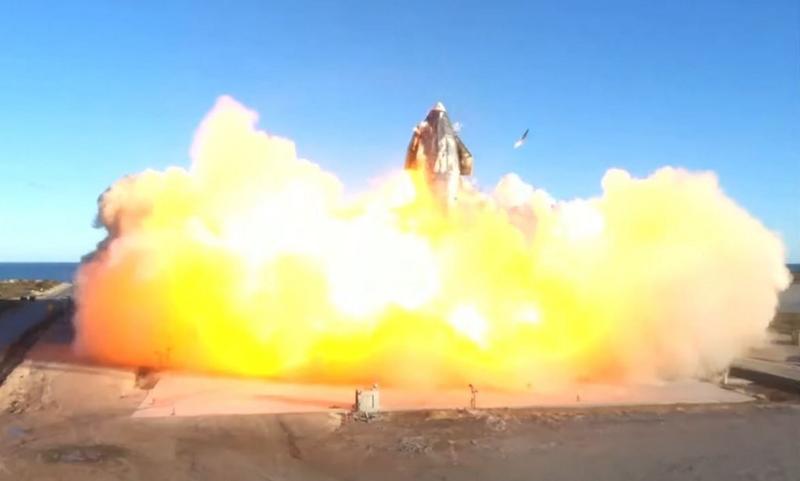 This image grab taken from a SpaceX video shows SpaceX's Starship SN8 rocket prototype crashing on landing at the company's facility in Boca Chica, Texasm during an attempted high-altitude launch test on Dec 9, 2020.
(SPACEX / AFP)
This image grab taken from a SpaceX video shows SpaceX's Starship SN8 rocket prototype crashing on landing at the company's facility in Boca Chica, Texasm during an attempted high-altitude launch test on Dec 9, 2020.
(SPACEX / AFP)
SpaceX’s Starship rocket prototype exploded during a return-landing attempt on Wednesday, minutes after an apparently uneventful test launch from the company’s facility in Boca Chica, Texas, live video of the flight showed.
The rocket destroyed was a prototype for a heavy-lift launch vehicle being developed to carry humans and 100 tons of cargo on future missions to the moon and Mars
The Starship rocket destroyed was a 16-story-tall prototype for a heavy-lift launch vehicle being developed by Elon Musk’s private space company to carry humans and 100 tons of cargo on future missions to the moon and Mars.
The self-guided rocket blew up as it touched down on a landing pad following a controlled descent. The test flight had been intended to reach an altitude of 12,500 meters, propelled by three of SpaceX’s newly developed Raptor engines for the first time.
READ MORE: SpaceX: Rocket for moon, Mars and NY-to-Shanghai in 39 mins
Musk said in a tweet immediately following the accident that the rocket’s “fuel header tank pressure was low” during descent, “causing touchdown velocity to be high.”
He added that SpaceX had obtained “all the data we needed” from the test.
SpaceX made its first attempt to launch Starship on Tuesday, but a problem with its Raptor engines forced an automatic abort just one second before liftoff.
 This frame grab from video posted on SpaceX's Twitter page shows views of SpaceX's Starship rocket just after an automatic engine abort occurred with only 1.3 seconds remaining in the countdown to liftoff of its first high-altitude test flight, in southeast Texas, on Dec 8, 2020. (PHOTO / SPACEX VIA AP)
This frame grab from video posted on SpaceX's Twitter page shows views of SpaceX's Starship rocket just after an automatic engine abort occurred with only 1.3 seconds remaining in the countdown to liftoff of its first high-altitude test flight, in southeast Texas, on Dec 8, 2020. (PHOTO / SPACEX VIA AP)
The complete Starship rocket, which will stand 120 meters tall when mated with its super-heavy first-stage booster, is the company’s next-generation fully reusable launch vehicle - the center of Musk’s ambitions to make human space travel more affordable and routine.
NASA awarded SpaceX US$135 million to help develop Starship, alongside competing vehicles from rival ventures Blue Origin, the space company owned by Amazon billionaire Jeff Bezos, and Leidos-owned Dynetcis.
ALSO READ: Japan lunar exploration firm to head for moon on SpaceX rockets
Hawthorne, California-based SpaceX, has been buying up residential properties in the Boca Chica village situated just north of the US-Mexico border in southeastern Texas to make room for his expanding Starship facilities, which Musk envisions as a future “gateway to Mars.”
Musk has faced resistance from Boca Chica residents unwilling to sell their homes.


